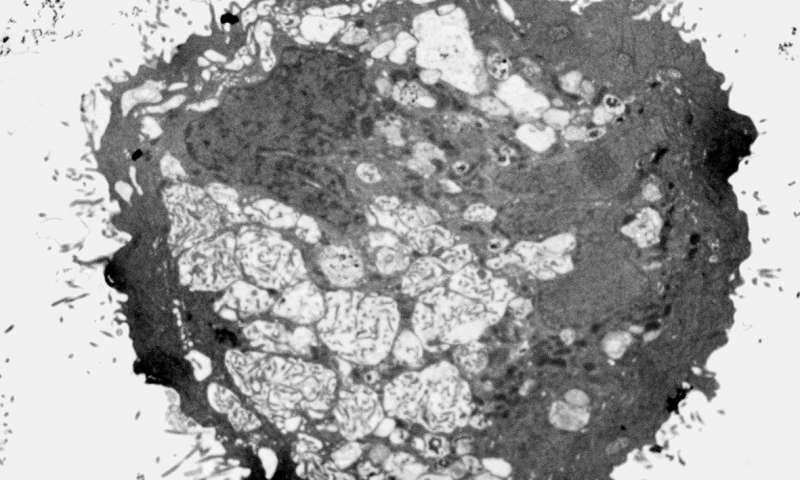
Self-destructing brain tumor cell captured by electron microscopy after treatment with the small molecule KHS101. Credit: Stem Cells and Brain Tumour Group, University of Leeds.
British researchers were experimenting with various chemicals that they hoped might slow down the growth of glioblastoma — the most aggressive cancer that starts out in the brain. To their surprise, one synthetic chemical called KHS101 did far more than expected, basically destroying the cancer cells completely. These surprising findings may pave the way for a novel drug treatment that might one day save people’s lives from a very aggressive form of cancer.
The research team at the University of Leeds found that the chemical disrupted the mitochondria and metabolism of brain tumor cells collected from patients. What this means is that the cancer cells no longer had access to energy, leading to their self-destruction.
Glioblastoma is one of the deadliest, unforgiving cancers out there, with a five-year survival rate of less than 5%. In the United States, almost 23,000 adults were diagnosed with brain tumors in 2015, of which over 50 percent are glioblastomas.
“This is the first step in a long process, but our findings pave the way for drug developers to start investigating the uses of this chemical, and we hope that one day it will be helping to extend people’s lives in the clinic,” said Dr. Heiko Wurdak, from the University of Leeds who led the international research team.
Wurdak and colleagues transferred tumor cells from humans to mice in order to study KHS101’s capability of crossing the mammalian blood-brain barrier — a network of blood vessels and tissue that is made up of closely spaced cells and helps keep harmful substances from reaching the brain. The blood-brain barrier lets some substances, such as water, oxygen, carbon dioxide, and general anesthetics, pass into the brain, but it also keeps out bacteria and other substances, such as some substances that we’d like to cross to the brain like many anticancer drugs.
KHS101 could successfully cross the blood-brain barrier in mice, where it decreased tumor growth by 50% compared to the mice that were given a placebo. Normal brain cells were not affected by the chemical.
Finally, the researchers tested whether KHS101 would be effective against multiple genetic profiles of cells within a tumor. Previously, genetic variants have ruined cancer treatments in the past but, fortunately, all subtypes of glioblastoma cells responded to the treatment.
“Treatment for glioblastoma has remained essentially unchanged for decades, so there is a pressing need for preclinical research like this to identify and characterize potential new drugs,” said Professor Richard Gilbertson, Cancer Research UK’s brain tumor expert.
“While the findings are encouraging, as an experimental chemical, further rigorous testing and refinement of KHS101 are required before trials in people can begin.”
KHS101 might not be the only chemical out there that can disrupt tumors cells. Understanding the chemical’s properties may help scientists come up with similar drugs that have a wider range of treatment against brain tumors.
The findings appeared in the journal Science Translational Medicine.









